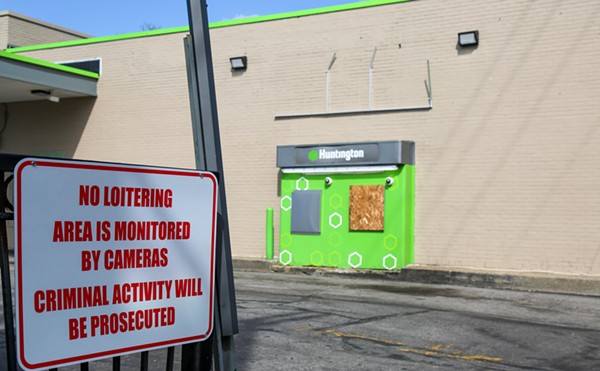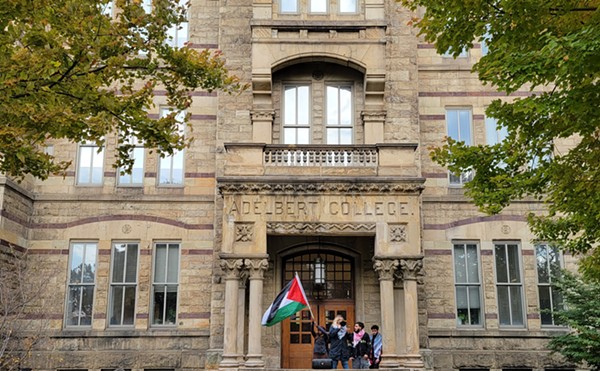Michael Gill, CAN Journal - On Community
What was the genesis of CAN?
CAN was first organized in 2011. And it was the typical marketing thing: You see a niche and fill it, although definitely not a money-making niche. It was a need. Liz Maugans at Zygote has been involved in trying to organize artists in a variety of ways for awhile, and in the wake of the big recession, she was trying to get them together and talk about things they can do in tough economic times to help each other.
Simultaneously, and really for the past 10 years, coverage of art has just tanked. And you can go through the magazines that don't exist anymore. There was Angle, there was Dialog, there was Urban Dialect, there was Pink Eye, there was both Free Times and Scene, which at times both had full sections covering the art world. All that stuff is gone, and the Plain Dealer, they would cover the museum, and they would cover MOCA, and once in awhile they would go to Bill Busta's gallery, but the number of galleries, and the number of working local artists and venues, it was almost nonexistent in the PD at that point. So, one of the ideas they came to was communication.
The idea arose in 2011 that they could make some printed piece that could be out in the world, and that would at least be something. In 2011, there were 28 of them, they all agreed to pitch in $100, and to draw names out of a hat and write about each other. And so that came out in January of 2012. We had the Plain Dealer print it. It was basically Friday magazine physically. It was conceived without a website. It was just this printed thing, without a distribution system set up.
So the galleries just set it out?
We had 28 galleries. We had a party when it came out, and they all took it back to their galleries. And basically that's where it was. There were other places to find it. For nonprofits, the Cuyahoga County libraries will put it on, but that was it. It was very grassrootsy, very DIY. I had been involved with the arts scene in a bunch of ways for a long time — I was at Beck Center before newspapers — and I recognized that to have that number of organizations working on the same project and putting in money was really remarkable. The fact that they all responded like that, voluntarily spent money, we weren't giving out money, that was remarkable. So I did follow-up interviews with as many of them as I could, and figured out if they wanted to go forward and how. And that's how we got here.
They wanted it to be beautiful, they wanted it to be quarterly, they wanted to have some news and time sensitivity. The one-time thing, it had no news value; it was a reference. This is who we are, this is how we were founded. Those were the big shifts. We got a big boost from Consolidated Graphics, who printed it for free the first year, which was a gift of about $70,000. And after that, we're shifting toward paying more of our fair share. And growing it toward sustainability.
I mean, is this the longest running arts journal in Cleveland history by now?
No. We're beginning our third year. I believe Angle might have published for three years. Dialog had fits and starts, but it ran for a long time, maybe for 10 years.
How many copies do you print?
10,000.
And where do you distribute?
There are about 200 places around the county. Heinen's. The libraries. We go a little bit into Medina and Akron, because of some advertisers and members.
What's changed since you first started covering the arts in Northeast Ohio 20 years ago?
It's tied to the whole, you know, rust belt cities evolution. There is so much empty space that's so cheap. If you're an artist and you want to do something in town, you can. You can find space. The result of that is that, I think, the city has only recently bought into the idea that artists moving into those spaces can be good for the neighborhood. There's more systematic recognition and support of the relationship between artists and neighborhoods.
In Tremont, it was very organic. It was a forgotten neighborhood where you might not be able to sell your house for $10,000. Artists could afford it and, individually, they began to move in. In Gordon Square, it was much more organized. The Gordon Square Arts District was this triumvirate of established organizations. There was Cleveland Public Theatre, the Capitol Theater, and I think Near West Theatre is the third. They formed an organization, an independent nonprofit that raised money for projects in the neighborhood.
It was similar over in Waterloo, but carried out in a different way. They had all those houses, and the Beachland had been there trying to make some of that happen. But it wasn't catching on much. Nothing much happening. The community development corporation, Northeast Shores, got some significant grant funding. They decided that they were going to use the money to enable artists to move in, but not in the usual way.
On the other side, what are the obstacles for people to open galleries?
The whole Loren Naji story would be the thing that comes to mind. I mean, that big macro picture is really the big, long-term challenge. It's the long, steady need to make money. No matter how you look at it...
I don't want to get too deep on the Naji story, but is there some fundamental perception that these people just aren't used to dealing with building codes and stuff like that? That the city should be a bit more proactive?
There is that. You have to follow the rules. The rules are written, and it's all there for you. It's also true that there are a whole lot of Cleveland businesses that aren't following the rules, and no one's paying attention and no one's called the police. His situation is really because someone took up the charge to look into the details that most people haven't looked after. For Cimperman and the people that run Ohio City Inc. and several other people to say very similar things, that half the buildings in my ward don't have occupancy permits, you know, I guess I take that as true. I've heard it from multiple sources.
Michael Gill is the editor and publisher of CAN Journal. Visit canjournal.org to learn more.
Liz Maugans, Zygote Press - On Advocacy
What's your take on the sense of optimism in the arts community here? Do you get that sense?
I think that it's exciting — all the stuff that's going on, all the stuff that's percolating. A lot of it can be attributed to us not looking at competition anymore, but looking at collaboration. It used to be the big guys and then all the rest of us. What the rest of us are doing really well — connection, audience, pop-ups, connecting with neighborhoods — that momentum is something that impenetrable organizations like the museums grafted. They are definitely doing the Wade Ovals, the different types of community connections that are helping out younger organizations and the organizations with smaller budgets. I feel like that had never happened before.
There are a lot of towns — like, I just went to Toledo. They have the opera and the orchestra up here (gestures), and then they have a lot of the other, sort of more street-level organizations that are still just figuring it out very separated. They don't have the foundation support we have in Cleveland. They don't have the public-sector funding. And they certainly don't have a Cleveland Arts Prize. Those are all validating forces that allow us to appreciate what artists do and value artists in our society. They don't look at us as fringey lost souls that they don't need to wait to talk to until they're done with a civic project and they need a sculpture in their garden.
There have been some mixed opinions as far as civic support for Cleveland artists this year.
I do feel like that could be more reinforced. We could do with a representative that is a member of county council and the city of Cleveland. An arts czar. Someone who deals with the board of zoning and permits and sits at the table to be an advocate for artists and for the cultural sector. This would be someone who could think differently and add a different type of perspective and view in how we can involve ourselves.
Setting up an actual advocacy role in the government: Is that something that would help?
Totally. A lot of people look at Tom Schorgl [ed note: Community Partnership for Arts and Culture CEO] as that person who's positioned there, but he's a policymaker. He's the one that can't talk emotionally about these metrics and this research and data that's coming in.
You were an early figurehead at CAN Journal, raising awareness for the arts that way. Outside of established public office and mainstream media outlets, that seems like the best way of getting the word out. And it seems to be really gaining steam, right?
Yeah, it's been one of those things that has given us our own voice. We're not waiting around for our only art critic. We could have not been more prescient in knowing that The Plain Dealer was going to reduce its distribution and printing. We started seeing it slowly veer away, from Angle, from Dialog, all those things that don't exist anymore. When you see this super sexy tome of different types of interviews and elaboration on what an artist's life is like or on what an exhibition is all about, that's something that creates a better playing field. It made us all much more encouraged and supportive of each other.
It made us work harder and be better at our businesses and relaying our messages to the outside world. You wouldn't have had the fantastic places like 78th Street Studios and the Screw Factory — these artist hives — working together. Before, it was just a bunch of artists in a building. Now, they're tour-de-forces that everybody has to go to.
Bringing back all this cool stuff, like Party in the Park, has been great too. It makes complete sense to have artists and arts organizations down there, involved and creating moments on, say, beaches. All that stuff is beautifully rich and it just wasn't here 10 years ago. I feel like CAN certainly has had a part in that.
The community is sustaining itself and not relying on some art critic to come by and review a show. That's never going to happen.









